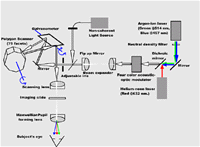


VRD Emulator main page
VRD Emulator
Virtual Retinal Display (VRD) scans intensity modulated laser light pixels directly onto retina. Each pixel is modulated in short pulses of 30ns to 40ns. The input light is a combined beam from three different wavelengths of laser light which produces a color gamut exceeding that of a conventional CRT. The area covered by the laser spot on the back of the retina for the duration of a single pixel is called a 'retinel'.
Unlike CRT monitors, the VRD has no phosphor persistence but depends on the light-gathering properties of the photoreceptors and the temporal integration properties of the visual system. Therefore, the interactions between the VRD delivered light and the psychophysical image quality created by the brain are of extreme importance for future enhancements.
The enhanced image quality of the VRD is believed to be the result of several system properties:
- Small exit pupil which gives large depth of focus
- Beam size which minimizes optical aberrations at cornea
- Laser light penetrates mild to moderate media opacities with minimal scattering
- High luminance and high color contrast
- Collimation and coherence of the light
- Decreased flicker sensitivity
- No perceptual laser speckle
Unfortunately, the current VRD design does not provide a way to test many of the these system properties. Therefore an Emulator of the VRD has been developed.

|
|
|
The emulator system requires a scanned light sources of the emulator to be modulated by passing the light through a 35mm slide. This provides us with the capability to:
- Vary spot size at the retina.
- Vary the spacing between between horizontal lines
- Vary the spacing between pixels
- Vary scan rates of the system
- Investigate coherent versus incoherent light
- Control light intensity
- Use a common source of modulation
- Match laser lines of VRD (645, 514, 472 nm)and other color combinations
- Characterize optical parameters
- Automate data collection
Our predicted results include:
- Contrast sensitivity at lower spatial frequencies will be higher.
- Possible shift at higher spatial frequencies but not as likely.
- Subject's critical flicker thresholds should be consistently higher with the VRD relative to the CRT.
- Retinels size should be able to approach foveal cone spacing.
- As retinels approach cone spacing line separation will become less tolerant.
- Light coherence will have minimal effect on the enhanced performance. The point and angle of entrance beams at the corneal surface will be identified as major contributors to the enhanced performance.
Contacts
Robert (Bob) Burstein <bbb![]() hitl.washington.edu>
hitl.washington.edu>